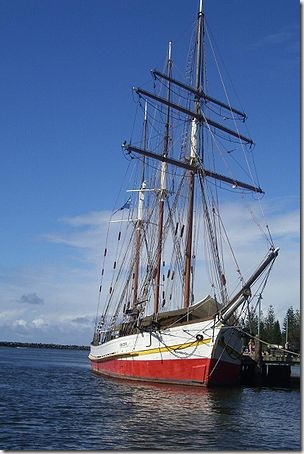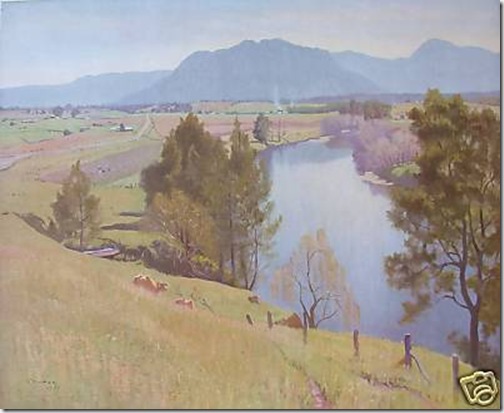This painting by Elioth Gruner (1882 - 1939) shows the Bellinger River stretching back towards the escarpment.
Gruner in fact called the river Bellingen, but the river itself is the Bellinger, the main town on the river is called Bellingen.
The Bellinger Valley is one of the most beautiful river valleys in New England, although most travellers on the coastal Pacific Highway never get to see the true beauty.
I do not know how many times I have been through Bellingen over the years, but it is a lot.
The road from Dorrigo down the escarpment was always a fascinating trial, especially when still dirt. Narrow and winding, the way was often blocked by timber jinkers sometimes carrying a huge single log.
These were seriously big trees.
The Alma Doepel was launched into the Bellinger River in 1903. Hard to believe looking at the river at Bellingen now that an ocean going sailing ship could be launched there. Even then, the river had to be dredged for the launch. 
The keel of the Alma Doepel measured 14 inches by 6 inches (35.5 x 150 cm) and is 100 feet (30.5m) long and was cut from half a tree. The ship survives today and can be visited at her moorings at Port Macquarie.
The road from Dorrigo really enters the Bellinger Valley as you cross the bridge at Thora. Suddenly, the Valley begins to open out. The river here is low, wandering over the stones.
Soon after after Thora on the left was a farm house belonging to the family of a university friend. This was perched on high ground, a very necessary location.
The Bellinger River here seems so small and peaceful. However, the Dorrigo mountain is one of the wettest parts of New England. Sometimes the cyclonic systems coming south from Queensland can dump huge amounts of rain in very short time.
One year we were staying at Sawtell on the coast near Coffs Harbour. A cyclone was coming. It was wet and drizzling as we walked along the beach with large but very choppy waves. There was no one else on the beach.
We walked into the water, but only up to our ankles. Even then, the rip threatened to tear our feet from under us.
That night the heavens opened. At Dorrigo, there were 24 inches (610mm) in 24 hours. Walking in the rain on the beach next day, we found that the high sand dunes had been turned into sharply edged cliffs by the waves. The Bellinger rose and rose, spreading out across the coastal plains.
A few days later we had to drive home. The river had dropped, but the country was still sodden. I had just got my driver's license, and was driving for practice. The car slipped and slipped in the wet mud. We were going so slowly that my father finally took over the driving. 
Bellingen itself was a quiet rural service centre, a place where the wooden buildings in the main centre crowded close to the road.
This quietness saved Bellingen. Down on the coast itself, the later development wiped out a lot of the past. Not so in Bellingen.
Unscarred by development, located in a beautiful river valley, Bellingen became a centre for alternative life styles. This is the Bellingen of Pip Wilson.
This photo by the inimitable Gordon Smith is simply called Bellingen: the chess players.It captures one aspect of Bellingen today.













No comments:
Post a Comment